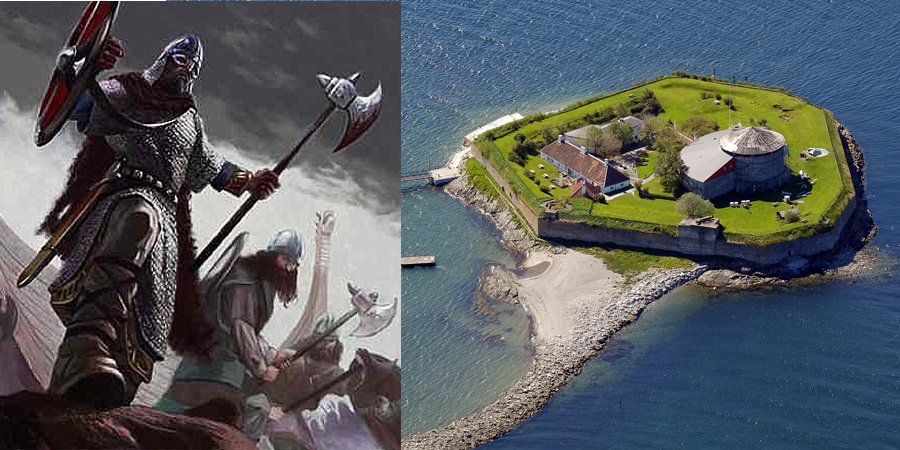Munkholmen: Island With Intriguing Yet Dark And Scary History
A place does not have to be large to have long and rich history. Munkholmen is certainly proof of that.

Located in the Trondheim fjord, Norway, Munkholmen is a beautiful small island that is today a popular tourist destination. However, this was by no means the case in the past. Visiting Munkholmen was something most wanted to avoid at all cost.
The small island has a very intriguing, yet dark and scary history.
During the Viking Age, Munkholmen served as a main place for execution. Heads of enemies of the state were placed on stakes as a warning to potential enemies.
Olav Tryggvason, Viking King of Norway from 995 to 1000, ordered to place the severed heads of Haakon Sigurdsson and Tormod Kark on stakes as warning to visitors.
According to legends, those who visited the island must spit on the heads to pay tribute to King Olav Tryggvason.
The tradition of displaying severed heads on stakes continued for some years. What changed was that the heads of criminals and political enemies were placed so that they faced the city of Trondheim instead.
It was considered an efficient method to deter citizens from committing crimes.
Later a monastery was established on Munkholmen, but who came up with the idea is a question of historical disagreement.
According to English sources, King Cnut the Great established the monastery in 1028.
If we instead rely on Norwegian and Icelandic sources, we learn that it was one of Magnus Berrfot’s men, Sigurd Ullstrengson, who was the founder of Holm (Nidarholm) monastery in the early 12th century. This particular monastery was part of the Cluniac order and worshipped Saint Benedict and Saint Lawrence.
With a monastery on the island one would think the bloody history of Munkholmen had come to an end. However, this was not the case.
The island continued to be used for keeping prisoners. King of Norway Magnus IV Sigurdsson (ca. 1115-1139) also known as Magnus the Blind was captured and placed on Munkholmen as a prisoner between 1135 and 1137. Later he joined the monastery as a monk.
The monastery on Munkholmen was one of the first monasteries in the Nordic countries. However, it was damaged by fire on several occasions, in 1216, 1317 and 1531.
Sometime people who tried to escape the prosecution of the Reformation fled to Munkholmen and hid in the monastery, but at the end they always had to surrender.
Following the Swedish siege of Trondheim in 1658 and the reconquest of the city the following year by Danish and Norwegian troops, a fortress was erected on Munkholmen.
The fortress was completed in 1707 and much of it has survived until today.
In the 17th and 18th century the island was used as a State Prison.
Those who were transported to Munkholmen were in most cases political prisoners. The most famous who served time here was Peder Griffenfeld, a Danish statesman who was imprisoned on Munkholmen for 18 years.
Today, when you set foot on the island you will find a lovely beach, a restaurant and café, but the place is of great historical importance and one is always reminded of the events that took place here.
Written by Ellen Lloyd – AncientPages.com
Copyright © AncientPages.com & Ellen Lloyd All rights reserved. This material may not be published, broadcast, rewritten or redistributed in whole or part without the express written permission of AncientPages.com and Ellen Lloyd
About the author:Ellen Lloyd – is the owner of AncientPages.com and an author who has spent decades researching ancient mysteries, myths, legends and sacred texts, but she is also very interested in astronomy, astrobiology and science in general



 Creators of mankind
Creators of mankind Description of “Tall white aliens”
Description of “Tall white aliens” Where they came from?
Where they came from? About hostile civilizations
About hostile civilizations The war for the Earth
The war for the Earth “Tall white aliens” about eternal life
“Tall white aliens” about eternal life Video: “Nordic aliens”
Video: “Nordic aliens” Aliens
Aliens Alien encounters
Alien encounters The aliens base
The aliens base UFO
UFO Technology UFO
Technology UFO Underground civilization
Underground civilization Ancient alien artifacts
Ancient alien artifacts Military and UFO
Military and UFO Mysteries and hypotheses
Mysteries and hypotheses Scientific facts
Scientific facts


















